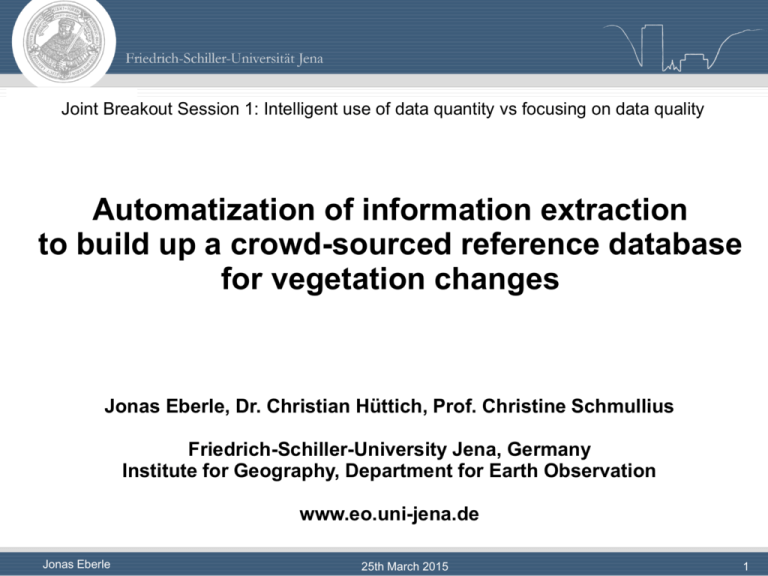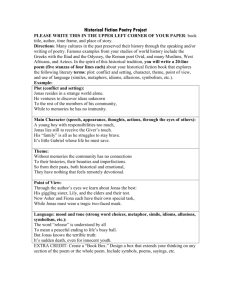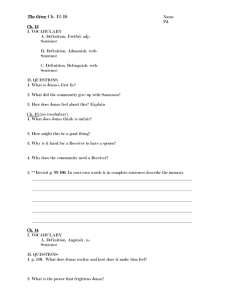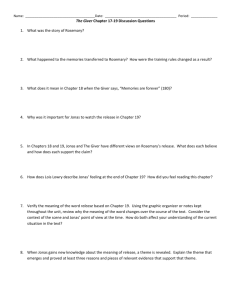presentation
advertisement

Joint Breakout Session 1: Intelligent use of data quantity vs focusing on data quality Automatization of information extraction to build up a crowd-sourced reference database for vegetation changes Jonas Eberle, Dr. Christian Hüttich, Prof. Christine Schmullius Friedrich-Schiller-University Jena, Germany Institute for Geography, Department for Earth Observation www.eo.uni-jena.de Jonas Eberle 25th March 2015 1 Lots of data is freely available • MODIS • Sentinel – Resolutions – Resolutions • Medium spatial (up to 250m) • Up to daily temporal • Medium spatial • High spatial • Different temporal resolutions – Products • Vegetation, Fire, LST, … • Landsat – Resolutions • High spatial • 8- 16-days temporal • Climate station data – Resolutions • Hourly, Daily temporal – Products • Temperature, Precipiation, ... Jonas Eberle 25th March 2015 2 Lots of data is freely available How to get these data? • OpenSearch Web Service – Sentinel – ESA Data Hub • FTP/HTTP – MODIS – Climate station data (NOAA) • Browser-based applications • Google Earth Engine – MODIS – Landsat 1-8 Jonas Eberle – USGS Earth Explorer – NASA Reverb – etc. 25th March 2015 3 How to process available data? 1. 2. 3. 4. 5. Find download files Download data Convert data Clip data to study area Apply quality masks For any dataset For different data formats For any time stamp Jonas Eberle 25th March 2015 4 Intelligent use of data quantity • What is needed? 1. Automation in data access 2. Easy to use clients 3. Possibility to create / publish new information • What should be achieved in our case? – Try to explain a change detected in the time series Evaluate changes based on additional data – Easy use of a wide range of datasets (no processing needed) Interactive change evaluation of spatial time-series data Create new knowledge and information Jonas Eberle 25th March 2015 5 Intelligent use of data quantity 1. Automation in data access – Data Processing Middleware – Standardized data publishing • OGC Web Services – Necessary inputs • Name of dataset • Geometry (Point, Polygon) • Further optional parameters Jonas Eberle Figure: Multi-Source Data Processing Middleware 25th March 2015 6 Intelligent use of data quantity 2. Easy to use clients – Web Portal • Modern web technologies • Based on web services • User accounts – Mobile Application • Data access & analysis tools in the field • GPS position Jonas Eberle 25th March 2015 7 Intelligent use of data quantity 3. Possibility to create / publish new information – Scientific algorithms has to be linked to automated data access Provide scientific algorithms as web services – Users can validate the results of these algorithms based on additional datasets and create new information • e.g., valid change areas We need automated data access linked with automated execution of scientific algorithms! Jonas Eberle 25th March 2015 8 Earth Observation Monitor Automated access, analysis, and monitoring of global vegetation time-series data Datasets: • MODIS 16-Daily Vegetation Index (NDVI, EVI) Data access: • Pixel or Polygon-based extraction service Analyses: • Trend calculations • Breakpoint detection • Phenological parameters Applications: • Web Portal • Mobile App (mobileEOM) for iOS and Android www.earth-observation-monitor.net Earth Change Monitor • Objectives – Detect areas based on environmental change events in high density time series data (MODIS) – Provide high resolution images (Landsat) of the pre- and after change events – Add further datasets to distinguish between different types of change – Provide simple tools for users and developers with web services and web interfaces. Make use of wide variety of available data (data quantity) to create new information to build up a reference database. Jonas Eberle 25th March 2015 10 Intelligent use of data quantity Concept of the „Earth Change Monitor“: Jonas Eberle 25th March 2015 11 Focusing on data quality • We have to consider quality flags (if available!) when using data – Good example: MODIS products • Crowd-sourced reference database needs to be checked on errors / wrong interpretations – Access only to “experts” – Users can gain “expert” status for their user account – Users reference database vs. global reference database Use data quantity to increase quality of algorithm results (e.g., break-point in vegetation time-series) Jonas Eberle 25th March 2015 12 Conclusions • Crowd-sourced intiative can help scientists to better test their algorithms for information extraction and benefit from the input of users • Web 2.0 leads us to a new way of – how algorithms can be tested and – how a crowd-sourced reference database can be build up We need simple web services for data access linked with web services for algorithm execution registered to GEOSS EO time-series data are better useable and lead to new knowledge to further improve algorithms and validated reference information. Jonas Eberle 25th March 2015 13 Thank you for your attention! Questions? Contact information: Jonas Eberle Friedrich-Schiller-University Institute for Geography Department Earth Observation Loebdergraben 32 07743 Jena, Germany Acknowledgement: Friedrich-Schiller-University Jena and EU FP7 EuRuCAS project (No. 295068) for financing work and travel. Jonas Eberle 25th March 2015 phone: +49 3641 94 88 89 email: jonas.eberle@uni-jena.de 14




